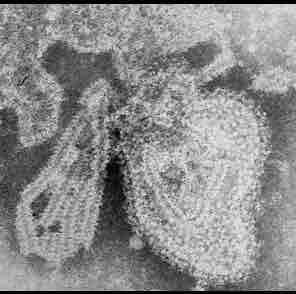Mumps, also known as epidemic parotitis, was a common childhood viral disease caused by the mumps virus. Before the development of vaccination and the introduction of a vaccine in 1949, it was common worldwide, but now, outbreaks are largely confined to developed countries.
Symptoms
The common symptoms of mumps include inflammation of the salivary glands, pancreas, and testicles; fever, and headache. Swelling of the salivary glands, specifically the parotid gland, is known as parotitis, and it occurs in 60–70% of infections and 95% of patients with symptoms . Parotitis causes swelling and local pain, particularly when chewing. It can occur on one side but is more common on both sides in about 90% of cases. Painful inflammation of the testicles in mumps in known as orchitis. Other symptoms of mumps can include dry mouth, sore face and/or ears and occasionally, in more serious cases, loss of voice. In addition, up to 20% of persons infected with the mumps virus do not show symptoms, so it is possible to be infected and spread the virus without knowing it. Fever and headache are prodromal symptoms of mumps, together with malaise and loss of appetite.

Child with mumps
This child with mumps displays the typical swelling of the salivary glands caused by the mumps virus.
Cause
Mumps is a contagious disease that is spread from person to person through contact with respiratory secretions, such as saliva from an infected person. When an infected person coughs or sneezes, the droplets aerosolize and can enter the eyes, nose, or mouth of another person. Mumps can also be spread by sharing food and drinks. The virus can survive on surfaces and then be spread after contact in a similar manner . A person infected with mumps is contagious from approximately six days before the onset of symptoms until about nine days after symptoms start. The incubation period can be anywhere from 14–25 days, but is more typically 16–18 days.

Mumps virus
This transmission electron micrograph (TEM) shows the ultrastructure of the mumps virus. It is a roughly spherical particle made up of layers of fatty lipids, large protein molecules, and nucleic acids. The virus is dotted with large protein 'spikes' that enable it to gain entry to host cells. Inside lies a core of a single, long molecule of RNA wrapped up in protein that is released into the host cell.
Diagnostics
A physical examination confirms the presence of the swollen glands. Usually, the disease is diagnosed on clinical grounds, and no confirmatory laboratory testing is needed. If there is uncertainty about the diagnosis, a test of saliva or blood may be carried out. An estimated 20%-30% of cases are asymptomatic. As with any inflammation of the salivary glands, the level of amylase in the blood is often elevated.
Prevention
The most common preventative measure against mumps is a vaccination with a mumps vaccine. The vaccine may be given separately or as part of the routine MMR immunization vaccine which also protects against measles and rubella. The MMR vaccine is given at ages 12–15 months and then again at four to six years.
Treatment and Complications
Like many other viral illnesses, there is no specific treatment for mumps. Symptoms may be relieved by the application of intermittent ice or heat to the affected neck/testicular area and by the acetaminophen or ibuprofen for pain relief. Warm salt water gargles, soft foods, and extra fluids may also help relieve symptoms. Patients are advised to avoid acidic foods and beverages, since these stimulate the salivary glands, which can be painful.
Death from mumps is very unusual. The disease is self-limiting, and general outcome is good, even if other organs are involved. Known complications of mumps include:
- In teenage males and men, complications from orchitis such as infertility or sub-fertility are rare, but present.
- Spontaneous abortion in about 27% of cases during the first trimester of pregnancy.
- Mild forms of meningitis in up to 10% of cases.
- Profound hearing loss is very rare, but mumps was the leading cause of acquired deafness before the advent of the mumps vaccine
After the illness, life-long immunity to mumps generally occurs; re-infection is possible but tends to be mild and atypical.